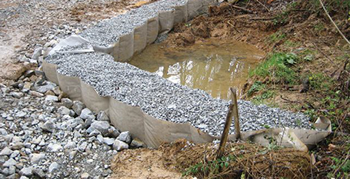 Excavating, grading and other construction activities have a detrimental impact on land and surrounding areas. Disturbed soil, when improperly managed, easily washes away from construction sites during storms, entering nearby lakes and streams. Sediment runoff rates from construction sites typically are 10 to 100 times greater than those of undisturbed land and natural forested areas, making stormwater runoff one of the leading causes of water pollution nationwide.
Excavating, grading and other construction activities have a detrimental impact on land and surrounding areas. Disturbed soil, when improperly managed, easily washes away from construction sites during storms, entering nearby lakes and streams. Sediment runoff rates from construction sites typically are 10 to 100 times greater than those of undisturbed land and natural forested areas, making stormwater runoff one of the leading causes of water pollution nationwide.
To help alleviate ongoing pollution from construction efforts, the U.S. Environmental Protection Agency (EPA) currently is conducting research to determine the optimum effluent limitations guidelines (ELGs) required for the outfalls from construction and development sites. In 2009, the EPA proposed new standards relative to the numeric turbidity standard for outfalls from construction and development sites. The proposal specifies that ELGs be monitored, measured to meet or exceed guidelines during precipitation events that are equal to or less than a two-year, 24-hour storm. Final revised standards are expected from the EPA within the next year or two.
As the agency continues to fine-tune the final guidelines, state and local regulatory agencies are paying increasing attention to stormwater runoff from construction sites and, in some cases, requiring that additional measures are taken to reduce sediment levels.
Regulatory Roadblock
Tazewell, Tenn., is a small town situated on the northern slope of Wallen Ridge in the Appalachians. In 2010, work was underway to build a new highway bypassing Tazewell. During construction, multiple freshwater springs below the site were disturbed, causing them to open up and allowing sediment-laden runoff from the construction site to enter the springs. These springs discharged into a nearby blue-line stream capable of supporting aquatic life, violating standards set by the state agency responsible for water quality.
The contractor on site attempted to mitigate the runoff by installing a paved ditch along one side of the road, engineered to prevent sediment from entering the natural springs. The rough terrain, ongoing blasting and location of the new roadway impeded the performance of the ditch; sediment continued to enter the natural springs.
Unable to divert the runoff from the springs, construction workers built several temporary sediment ponds from straw wattles to slow the water flow and filter the sediment. The approach was partially effective—reducing some sediment—but not to the levels requested by local stormwater regulators. In addition, the solution proved labor-intensive, requiring monthly cleaning and maintenance.
Civil & Environment Consultants Inc. (CEC), an erosion and sediment inspection and consulting firm, tapped the technical expertise of engineers with Fiberweb Inc., a producer of geosynthetic materials with production facilities in Old Hickory, Tenn.
Fiberweb’s technical consultant worked with the construction team to develop and install three sediment traps made from Typar geocells composed of a durable, nonwoven fabric in a honeycomb configuration.
The geocells effectively filtered the runoff, removing almost all sediment.
Three individual sediment traps were constructed from geocells, a 3-D geotextile that can be filled with aggregate or mulch to produce a stable, self-supported erosion and sediment structure. Water flows through the structure while soil particles are retained, thereby reducing turbidity in stormwater runoff. Using geocells to manage site runoff is a relatively new stormwater management and filtration approach in the U.S. market, although this product has been used in the defense markets for the past 10 years.
Tests conducted by CEC showed that geocells composed of a nonwoven geotextile achieved an average daily turbidity limit of 280 NTUs. Runoff from a typical construction site measures tens of thousands of NTUs.
In Tazewell, each geocell unit was filled with No. 57 stone (3/8 in. to 1/2 in.) by a track hoe and workers. Prior to placing the new sediment traps, the straw and coir wattles were removed and the existing sediment trap was pumped down and cleaned out.
 |
The modified sediment trap for Spring No. 1 consisted of two geocell units in a ring formation. The ends at the joint of the two units were sealed with a 4-ounce geotextile wrapped around the joint to prevent leakage. The outfall that crossed the temporary access road was used to transfer the filtered stormwater into the existing stream.
Spring No. 3 posed a similar environment, although the total area was slightly larger. The contractor used three geocell units in a side-by-side installation to provide adequate coverage. Spring No. 5’s location made the working and installation area difficult to access. The modified sediment trap had to be installed adjacent to the existing stream, requiring the contractor to stack the units in a double layer to achieve enough capacity to treat the sediment-laden stormwater.
Once double stacked, the contractor installed an emergency overflow on the geocells system. The emergency overflow was wrapped with a 4-oz geotextile to prevent the aggregate from being washed out during high flow times.
For the Long Run
Almost two years after the completion of the highway project, the geocellular sediment traps continue to filter sediment-laden stormwater to the standards required by local storm water officials. The standard set by the regulatory agency requires that runoff entering the nearby blue-line stream be at the same clarity as the stream water, per a visual inspection.
Brian H. Whitaker, P.E., CPESC, is technical sales manager for Fiberweb Geosynthetics. Whitaker can be reached at bwhitaker@fiberweb.com.











